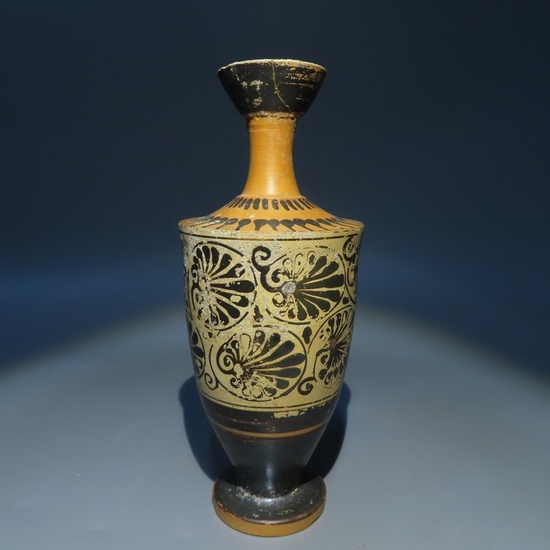Ancient Greek Pottery Attic, Black figures Lekythos. 490 BC. 16 H. Nice quality. Spanish Export License.
Lekythos\r
\r
- nice decoration - \r
\r
Greek, Attic, 490 BC\r
\r
MATERIAL: Pottery\r
\r
DIMENSIONS: Height 16 cm \r
\r
CONDITION: Good condition, has a line of torua on the lip, rejoined. \r
\r
PROVENANCE: Private collection, Lemoine, Caen, France, 1960. Old label on the base. \r
\r
A lekythos is a type of Greek pottery used to store perfumed oil to be used to anoint the body. This sort of vessel was also used for funerary purposes. It is characterized by its elongated form, narrow neck and wide mouth which facilitates application of the oil while controlling the flow. \r
\r
Red-figure pottery was one of the most important figurative styles of Greek production. It developed in Athens around 530 BC and was used until the 3rd Century AD. In the space of a few decades it took over the place of the previous dominant style of black-figure pottery. The technical base was the same in both cases but in red-figure pottery the colouring is reversed so that the figures stand out on a dark background as if they were lit up in a more natural way. The painters who did black-figure work were forced to keep the motifs they painted well apart one from the other and to limit their complexity. In contrast, the red-figure technique gave much greater liberty. Each figure was silhouetted against a black background, allowing the painters to portray anatomical details with greater accuracy and variety. \r
\r
\r
The technique consisted of painting the motifs on the vessels while they were still unfired using a transparent slip, which when fired took on a black coloration. In this manner the motifs were invisible before firing so that the painters had to work from memory without seeing their earlier work. Once the piece had been fired the zones which had not been covered by the slip retained the red colouring of the clay while the glossy areas, those that had been “painted, acquired a dense, brilliant black colour. \r
\r
THE MINISTRY OF CULTURE FROM SPAIN ASKS ALL SELLERS FOR INVOICES OR OTHER DOCUMENTATION ABLE TO PROVE THE LEGALITY OF EACH ITEM BEFORE PROVIDING AN IMPORT OR EXPORT LICENSE. \r
\r
\r
Notes: \r
- The piece includes authenticity certificate. \r
- The piece includes Spanish Export License. \r
- The seller guarantees that he acquired this piece according to all national and international laws related to the ownership of cultural property. Provenance statement seen by Catawiki.
View it on
Estimate
Time, Location
Auction House
Lekythos\r
\r
- nice decoration - \r
\r
Greek, Attic, 490 BC\r
\r
MATERIAL: Pottery\r
\r
DIMENSIONS: Height 16 cm \r
\r
CONDITION: Good condition, has a line of torua on the lip, rejoined. \r
\r
PROVENANCE: Private collection, Lemoine, Caen, France, 1960. Old label on the base. \r
\r
A lekythos is a type of Greek pottery used to store perfumed oil to be used to anoint the body. This sort of vessel was also used for funerary purposes. It is characterized by its elongated form, narrow neck and wide mouth which facilitates application of the oil while controlling the flow. \r
\r
Red-figure pottery was one of the most important figurative styles of Greek production. It developed in Athens around 530 BC and was used until the 3rd Century AD. In the space of a few decades it took over the place of the previous dominant style of black-figure pottery. The technical base was the same in both cases but in red-figure pottery the colouring is reversed so that the figures stand out on a dark background as if they were lit up in a more natural way. The painters who did black-figure work were forced to keep the motifs they painted well apart one from the other and to limit their complexity. In contrast, the red-figure technique gave much greater liberty. Each figure was silhouetted against a black background, allowing the painters to portray anatomical details with greater accuracy and variety. \r
\r
\r
The technique consisted of painting the motifs on the vessels while they were still unfired using a transparent slip, which when fired took on a black coloration. In this manner the motifs were invisible before firing so that the painters had to work from memory without seeing their earlier work. Once the piece had been fired the zones which had not been covered by the slip retained the red colouring of the clay while the glossy areas, those that had been “painted, acquired a dense, brilliant black colour. \r
\r
THE MINISTRY OF CULTURE FROM SPAIN ASKS ALL SELLERS FOR INVOICES OR OTHER DOCUMENTATION ABLE TO PROVE THE LEGALITY OF EACH ITEM BEFORE PROVIDING AN IMPORT OR EXPORT LICENSE. \r
\r
\r
Notes: \r
- The piece includes authenticity certificate. \r
- The piece includes Spanish Export License. \r
- The seller guarantees that he acquired this piece according to all national and international laws related to the ownership of cultural property. Provenance statement seen by Catawiki.



